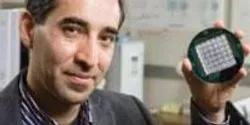Chemistry

The probe of an atomic force microscope (AFM) scans a surface to reveal details at a resolution 1,000 times greater than that of an optical microscope. That makes AFM the premier tool for analyzing physical features, but it cannot tell scientists anything about chemistry. For that they turn to the mass spectrometer (MS).

Light can come in many frequencies, only a small fraction of which can be seen by humans. Between the invisible low-frequency radio waves used by cell phones and the high frequencies associated with infrared light lies a fairly wide swath of the electromagnetic spectrum occupied by what are called terahertz, or sometimes submillimeter, waves. Exploitation of these waves could lead to many new applications in fields ranging from medical imaging to astronomy, but terahertz waves have proven tricky to produce and study in the laboratory. Now, Caltech chemists have created a device that generates and detects terahertz waves over a wide spectral range with extreme precision, allowing it to be used as an unparalleled tool for measuring terahertz waves.

When a scientist needs to concentrate a sample that’s in a volatile liquid—like acetone, acetonitrile, or methanol—a nitrogen evaporator can do the job. As a result, scientists use this technology in sample preparation in environmental, polymer science, quality control, and toxicology labs, plus others.

Researchers at the University of Manchester have made a significant breakthrough in the development of synthetic pathways that will enable renewable biosynthesis of the gas propane. This research is part of a program of work aimed at developing the next generation of biofuels.

Last year, the American Chemical Society's (ACS) Reactions series shook up the comedy world with a video featuring nothing but chemistry jokes. After overwhelming public acclaim, they're back for this April Fools' Day with round two, featuring a number of fan submissions
















